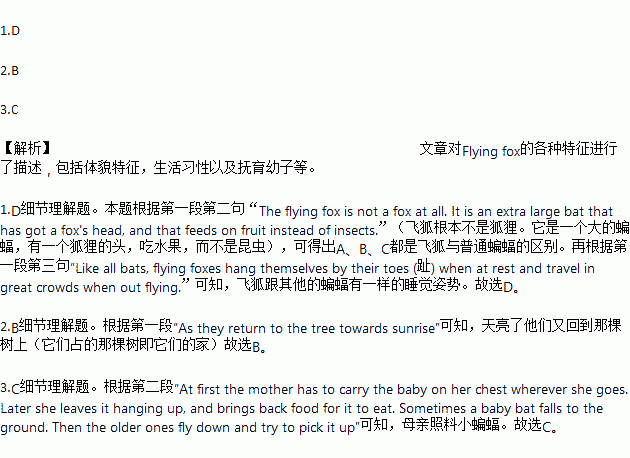题目内容
The flying fox is not a fox at all. It is an extra large bat that has got a fox’s head, and that feeds on fruit instead of insects. Like all bats, flying foxes hang themselves by their toes when at rest, and travel in great crowds when out flying. A group will live in one spot for years. Sometimes several hundred of them occupy a single tree. As they return to the tree toward sunrise.
Flying foxes have babies once a year, giving birth to only one at a time. At first the mother has to carry the baby on her breast wherever she goes. Later she leaves it hanging up, and brings back food for it to eat. Sometimes a baby bat falls down to the ground and squeaks for help. Then the older ones try to pick it up. If they fail to do so, it will die. Often hundreds of dead baby bats can be found lying on the ground at the foot of a tree.
1.The passage tells us that there is no difference between the flying fox and the ordinary bat in ________.
A. their size B. their appearance
C. the kind of food they eat D. the way they rest
2.At daybreak every day flying foxes begin to ________.
A. fly out toward the sun B. come back to their home
C. look for a new resting place D. go out and look for food
3.How do flying foxes care for their young?
A. They only care for their own babies.
B. They share the feeding of their young.
C. They help when a baby bat is in danger.
D. They often leave home and forget their young.
 阅读快车系列答案
阅读快车系列答案At the beginning of the twentieth century,many people thought that the American family was falling apart.A century later,we know that this was not the case.However,although the family is still alive in the United States,its size and shape were very different 100 years ago.
In the late 1800s and early 1900s,there were mainly two types of families in the United States: the extended and the nuclear.The extended family usually includes grandparents,parents,and children living under the same roof.The nuclear family consists of only parents and children.
Today there are many different kinds of families.Some people live in “traditional” families,that is,a stay?home mother,a working father,and their own biological children.Others live in two?paycheck families,single?parent families,adoptive or foster families,blended families (where men and women who were married before marry again and combine the children from previous marriages into the new families),childless families,and so on.
What caused the structure of the family to change? In the early 1900s the birthrate began to fall and the divorce rate began to rise.Women were suddenly choosing to go to college and take jobs outside the home.In the 1930s and 1940s,many families faced serious financial,or money problems during the Great Depression,when many people lost their jobs.During World War Ⅱ(1939-1945),5 million women were left alone to take care of their homes and their children.Because many men were at war,thousands of these “war windows” had to go to work outside their home.
During the next ten years,the situation changed.There were fewer divorces,and people married at a younger age and had more children than the previous generation.It was unusual for a mother to work outside the home during the years when her children were growing up.Families began leaving cities and moving into single?family homes in the suburbs.The traditional family seemed to be returning.
In the years between 1960s and 1990s,there were many important changes in the structure of the family.From the 1960s to the early 1970s,the divorce rate doubled and the birthrate fell by half.The number of single?parent families tripled,and the number of couples living together without being married doubled again.In fact,the single?parent household,once unusual,has replaced the “traditional” family as the typical family in the States.If we can judge from history,however,this will probably change again in the twenty?first century.
The Changes of the American Family
Main comparisons | Contexts | |
Different 1. | There were two 2.types of families in the past, 3.,the extended and the nuclear. | |
Nowadays 4.types of families can be seen than before. | ||
Changes in different 5. | In the 1900s and 1940s | Many of the women had to work outside due to the 6.of money,thus causing the fall of 7. and the rise of divorce rate. |
In the 1950s | Divorce rate slide and there were more children.The families tended to be 8.again. | |
In the years between 1960s and 1990s | Different types of families 9..Traditional families are no longer the typical ones in America. | |
A trend worth noting Author's opinion on changes | Judging from what has happened in the past,it is 10.that the present structure will experience changes again in the near future. | |


 C. turn out D. get around
C. turn out D. get around